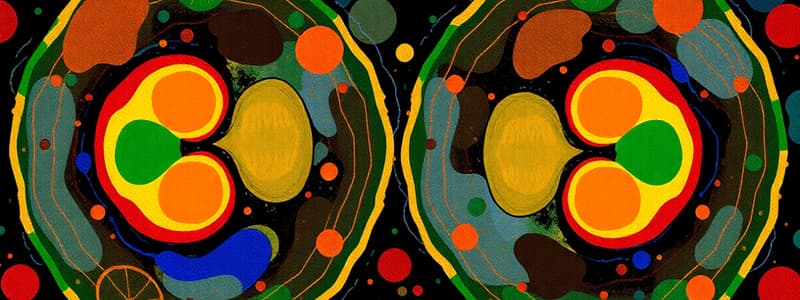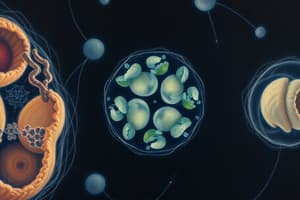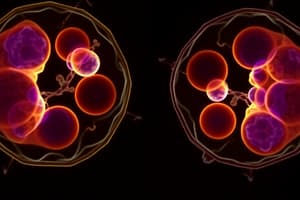Podcast
Questions and Answers
During which phase of meiosis do homologous pairs of chromosomes align along the equatorial plate?
During which phase of meiosis do homologous pairs of chromosomes align along the equatorial plate?
- Prophase I
- Telophase I
- Anaphase I
- Metaphase I (correct)
Which of the below events characterizes Anaphase I of meiosis?
Which of the below events characterizes Anaphase I of meiosis?
- Alignment of individual chromosomes along the metaphase plate
- Migration of homologous chromosome pairs to opposite poles (correct)
- Reformation of the nuclear envelope
- Separation of sister chromatids to opposite poles
What is the DNA content and chromosome number of the daughter cells after Telophase I, compared to the original diploid cell?
What is the DNA content and chromosome number of the daughter cells after Telophase I, compared to the original diploid cell?
- Diploid DNA content, haploid chromosome number
- Haploid DNA content, diploid chromosome number
- Diploid DNA content, diploid chromosome number
- Haploid DNA content, haploid chromosome number (correct)
Meiosis II is most similar to which process?
Meiosis II is most similar to which process?
If a diploid germ cell with 46 chromosomes undergoes meiosis, what is the expected number of chromosomes in each of the four resulting gametes?
If a diploid germ cell with 46 chromosomes undergoes meiosis, what is the expected number of chromosomes in each of the four resulting gametes?
During which phase of the cell cycle does DNA duplication occur?
During which phase of the cell cycle does DNA duplication occur?
Which of the following events is characteristic of the G1 phase of interphase?
Which of the following events is characteristic of the G1 phase of interphase?
During which phase of mitosis do the sister chromatids separate and migrate towards opposite poles of the cell?
During which phase of mitosis do the sister chromatids separate and migrate towards opposite poles of the cell?
What is the ploidy of an autosomal cell after the S phase, compared to its state before the S phase?
What is the ploidy of an autosomal cell after the S phase, compared to its state before the S phase?
Which of the following processes occurs during the G2 phase of the cell cycle?
Which of the following processes occurs during the G2 phase of the cell cycle?
Which of the following events does NOT occur during prophase of mitosis?
Which of the following events does NOT occur during prophase of mitosis?
Karyokinesis refers to which process?
Karyokinesis refers to which process?
What is the primary outcome of meiosis I?
What is the primary outcome of meiosis I?
What is the primary purpose of mitosis in multicellular organisms?
What is the primary purpose of mitosis in multicellular organisms?
At what stage of meiosis does crossing over, the exchange of genetic material between homologous chromosomes, occur?
At what stage of meiosis does crossing over, the exchange of genetic material between homologous chromosomes, occur?
Which event is exclusive to meiosis, distinguishing it from mitosis?
Which event is exclusive to meiosis, distinguishing it from mitosis?
Which of the following best describes the arrangement of chromosomes during metaphase of mitosis?
Which of the following best describes the arrangement of chromosomes during metaphase of mitosis?
What is the significance of the formation of chiasmata during meiosis?
What is the significance of the formation of chiasmata during meiosis?
How do the daughter cells produced through mitosis compare to the mother cell in terms of chromosome number and genetic content?
How do the daughter cells produced through mitosis compare to the mother cell in terms of chromosome number and genetic content?
Which of the following events occurs during telophase?
Which of the following events occurs during telophase?
If a germ cell in $G_2$ phase contains 46 chromosomes, how many chromatids are present?
If a germ cell in $G_2$ phase contains 46 chromosomes, how many chromatids are present?
Flashcards
Equatorial Plate (Meiosis I)
Equatorial Plate (Meiosis I)
Homologous chromosome pairs align at the cell's middle during Meiosis I.
Chromosome Composition (Meiosis I)
Chromosome Composition (Meiosis I)
Each chromosome consists of two identical sister chromatids during Meiosis I.
Anaphase I
Anaphase I
Homologous chromosomes separate and move to opposite poles of the cell.
Telophase I Outcome
Telophase I Outcome
Signup and view all the flashcards
Meiosis II Outcome
Meiosis II Outcome
Signup and view all the flashcards
Mitosis
Mitosis
Signup and view all the flashcards
Prophase
Prophase
Signup and view all the flashcards
Metaphase
Metaphase
Signup and view all the flashcards
Telophase
Telophase
Signup and view all the flashcards
Meiosis
Meiosis
Signup and view all the flashcards
Recombination
Recombination
Signup and view all the flashcards
Prophase I
Prophase I
Signup and view all the flashcards
Cell Cycle
Cell Cycle
Signup and view all the flashcards
Interphase
Interphase
Signup and view all the flashcards
G1 Phase
G1 Phase
Signup and view all the flashcards
S Phase
S Phase
Signup and view all the flashcards
G2 Phase
G2 Phase
Signup and view all the flashcards
Mitosis (M Phase)
Mitosis (M Phase)
Signup and view all the flashcards
Study Notes
- The cell cycle is a series of events within a cell, preparing it to divide into two daughter cells.
- Multiplication of cells occurs through the division of pre-existing cells.
- Multiplication is essential for embryonic development.
- The process is necessary after birth for growth and replacement of dead cells.
- There are two major events in the cell cycles: interphase and mitosis
Mitosis
- A type of division where the daughter cells must have chromosomes identical in number and genetic content to those of the mother.
Meiosis
- Consists of two successive divisions.
- Reduces the number of chromosomes to half the normal number.
- Genetic information in various gametes produced is not identical.
Interphase
- Long period of time in the cell cycle.
- During interphase, the cell increases in size.
- Content and replicate its genetics material during interphase.
Mitosis
- A shorter period of time compared to interphase.
- The cell divides its nucleus first, then its cytoplasm, resulting in two daughter cells.
- Cells may cease mitosis permanently, such as muscle and neuron cells.
- Cells that leave the cell cycle are considered to be in a stable phase, referred to as the G0 (outside) phase or a resting stage.
Interphase Subdivisions
- Interphase is further subdivided into three phases.
The G1 (Gap) Phase:
- Involves the synthesis of macromolecules essential for DNA duplication.
- Cells synthesize RNA, regulatory proteins, and enzymes essential to DNA replication.
- The cell volume is restored to normal.
- Nucleoli are reestablished.
- Centrioles begin to duplicate themselves and complete in the G2 phase.
The S (Synthetic) Phase:
- DNA is duplicated.
- Autosomal cells contain the diploid (2n) amount of DNA before the S phase, which doubles to 4n in preparation for cell division.
- All necessary nucleoproteins (histones) are manufactured and incorporated into DNA, forming chromatin.
- Cell contains twice the normal amount of DNA.
The G2 (Gap) Phase:
- Cells undergo preparation for mitosis
- The period between the end of DNA synthesis and the beginning of mitosis.
- RNA and proteins are synthesized, essential for cell division.
- Energy is stored for mitosis.
- Tubulin is synthesized for assembly into microtubules required for mitosis.
Mitosis (M)
- Occurs at the conclusion of the G2 phase and completes the cell cycle.
- It is the division of the nucleus called karyokinesis, followed by the division of the cytoplasm called cytokinesis.
- Mitosis is subdivided into four stages: prophase, metaphase, anaphase, and telophase.
Prophase
- The centrosome divides into two regions.
- Each half contains a pair of centrioles, which migrate away from each other to opposing poles of the cell.
- Chromosomes condense and become visible microscopically.
- Chromosomes are scattered randomly throughout the cytoplasm.
- Each chromosome consists of two parallel sister chromatids joined together at one point (the centromere).
- The nucleolus and nuclear envelope disappear.
Metaphase
- Chromosomes become maximally condensed
- Lined up at the equator of the mitotic spindle (metaphase plate configuration).
Anaphase
- Begins when sister chromatids pull apart and migrate toward opposite poles.
- In the late stages, a cleavage furrow begins to form at the plasma lemma during cytokinesis.
Telophase
- The terminal phase of mitosis.
- Complete cytokinesis (division of cytoplasm).
- Disappearance of spindle fibers
- Reconstitution of nucleus and nuclear envelope.
- Unwinding of the chromosomes into chromatin.
- Each daughter cell possesses a diploid (2n) number of chromosomes.
- Each daughter cell resulting from mitosis is identical in its genome.
Meiosis
- Is a special type of cell division resulting in the formation of gametes (spermatozoa or ova).
- The chromosome number has been reduced from diploid (2n) to haploid (1n) number
- Begins at the conclusion of interphase and produces germ cells (ova and sperm).
- This process has two crucial results:
- Reduction in the number of chromosomes from diploid (2n) to haploid (1n).
- Recombination of genes, ensuring genetic variability and diversity.
- It is divided into two separate events
Meiosis I (Reductional division)
- Separates the homologous pairs of chromosomes
- Reduces the chromosome number from diploid to haploid.
- In gametogenesis, where germ cells are in the S phase of the cell cycle preceding meiosis, the amount of DNA is doubled to 4n, but the chromosome number remains at 2n (46 chromosomes).
Prophase I:
- Lasts a long time
- Homologous pairs of chromosomes approximate each other, lining up and forming a synapse (tetrad).
- Chiasmata (crossing over sites) are formed, and a random exchange of genetic material occurs between homologous chromosomes.
Metaphase I:
- Characterized by homologous pairs of chromosomes lining up at the equatorial plate.
- Each chromosome is composed of two chromatids.
Anaphase I:
- Homologous pairs of chromosomes migrate away from each other to opposing poles.
Telophase I:
- Similar to telophase of mitosis.
- Nuclei are reformed, and cytokinesis occurs.
- Gives rise to two daughter cells.
- Each cell possesses 23 chromosomes (haploid number).
- Each chromosome is composed of two chromatids.
MEIOSIS II:
- Not preceded by an S phase (without DNA synthesis).
- Similar to mitosis, subdivided into prophase II, metaphase II, anaphase II, and telophase II.
- Chromosomes line up at the equator, the kinetochores attach to spindle fibers, chromatids migrate to opposing poles, and cytokinesis divides each cell into two cells.
- Each cell contains a haploid amount of DNA and a haploid chromosome number.
- Results in total of 4 cells from an original diploid germ cell.
- Each gamete contains its own unique genetic content.
Studying That Suits You
Use AI to generate personalized quizzes and flashcards to suit your learning preferences.




